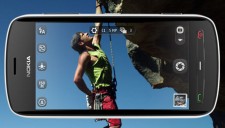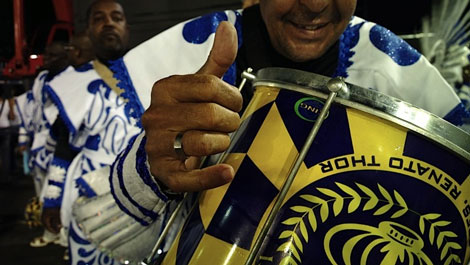Quite a piece of hardware, this Nokia 808 PureView, sporting a whopping 41MP sensor with Carl Zeiss lens. It’s not the slimmest of phones. The impressive camera tech means that the chassis with the rubberized finish looks more like a rugged, waterproof phone. But the 808 PureView is mostly about the optics — and audio, as you’ll learn later on. That’s right, it won’t just spank your iPhone in video quality.

Its molded plastic design allows the phone to outperform some pro-grade DSLR glass, claims a Nokia blog post, thanks to Carl Zeiss science of making the perfect lens.
+++ You can order the Nokia 808 PureView with Zeiss optics from Amazon. +++
DP Review posted a review — is this the site’s first smart phone camera review? The final word:
There are inexpensive compact cameras that offer more photographer-friendly features than the 808, but as a cameraphone, the Nokia blows its competition out of the water, and significantly narrows the gap between dedicated cameras and portable communications devices to the point where ultimate convergence seems all but inevitable (and probably sooner than some commentators had realised).
Nokia didn’t release the 808 PureView in the hope of making much of a dent in the smartphone market – the Symbian operating system is obsolete, and Nokia’s future plans are focussed on Microsoft’s Windows Phone OS. If you want an 808 in the USA, you’ll have to pay full price ($699) since no carrier (to date) is subsidizing the hardware through contracts on this side of the Atlantic. But while the Nokia 808 might not be an iPhone or Samsung Galaxy killer, it is a fascinating and compelling product, and one that has added a definite shine to Nokia’s reputation in the tech industry, which was looking a little tarnished, to say the least.
The 808 proves that Nokia can innovate, and its PureView technology has piqued the interest of serious photographers, being one of the most important innovations — arguable the most important — in mobile photography since the smarphone era dawned five or so years ago. As such, the 808 is intriguing not just in itself, but because of what it represents. Things could be about to get interesting…
Here’s a scene from the lab where Carl Zeiss demonstrates what making a perfect lens means when a scientist hefts a large cinematography lens off the table:
The walls of the corridor are lined with posters of famous films shot with this very piece of equipment — including Lord of the Rings, and The King’s Speech. He points out the cold feel of the aluminium body, the weight and the deep engravings that mean measurements can be read almost in the dark. Next to it he holds up a Nokia PureView 808 lens — the size of a sugar cube. “It’s the knowledge transfer between these two lenses,” he sighs “Perfect synergy.”
The phone’s optics are certainly revolutionary — even though the lens is made of plastic. That, on the other hand, has an advantage over glass, we learn:
The only reason you can’t make a larger camera lens from plastic is the physical size. A larger plastic surface area expands and shrinks too much at different temperatures, but that doesn’t apply on a lens as small as one fitted in a mobile phone.
Plastic gives mobile phone lenses one distinct advantage -– a dimple.
Glass can only be made in spherical shapes and to a certain extent pressed or polished to aspherical shape, but there are big problems with the way that it refracts light as soon as it comes to compact wide angle lenses like in camera phones, extreme aspheric lenses — that seem dimpled — are much better at refracting light in this case.
The phone’s OS is nothing special, old Symbian on the way out, but you can safely expect the PureView technology in a Lumia phone running Windows Mobile, according to WPCentral.
“Oversampling” may make the 808 PureView click for you, explains CNET:
Over-what-ing? Oversampling, for the uninitiated, is Nokia’s chosen term for what happens with the 41MP camera, which will usually resolve into a 3MP, 5MP or 8MP shot, depending on how you set your preferences (you’ll have a choice of three custom programs, by the way).
In a very tiny nutshell, oversampling means that the camera gathers 41 pixels worth of information, which it condenses down into a 5MP shot (or other settings). When you zoom in for a closer look, or blow up an image, or even print it out, it won’t look as muddled or blocky as blowing up an image could with some photos, since the digital information is already there.
And what’s hardly mentioned: the 808 PureView’s Rich Recording technology.
Hear the difference when Nokia Rich Recording comes in. First though a disclaimer: Listen to this video only if you have decent speakers or decent headphones. Listening through tinny laptop speakers will prevent you from appreciating Nokia Rich Recording:
Record everything, just as you would hear. Amazing. From the lowest base sounds to the highest treble tones.
Add the optics. Some first sample shots from the Nokia media kit — you even get a hint of bokeh with that tiny stunner of a lens:


The only downer: the 808 PureView still runs on Nokia’s antiquated Symbian — which Nokia is slowly ditching in favor of the Windows Phone OS.
Still, the 808 PureView topples standalone in blind camera test… What more you want from a camera phone?
Concert footage? Here you go:
ZDNet thinks the 808 PureView is worth the price of admission:
The Nokia 808 PureView is helping me look at the world around me a bit more as I seek out things to capture with the camera. The photos are so fantastic that I am now excited about mobile phone photography and rather than just accepting that photos taken with a phone are junk, I no longer have to compromise with the phone in my pocket.
+++ You can order the Nokia 808 PureView with Zeiss optics from Amazon. +++


